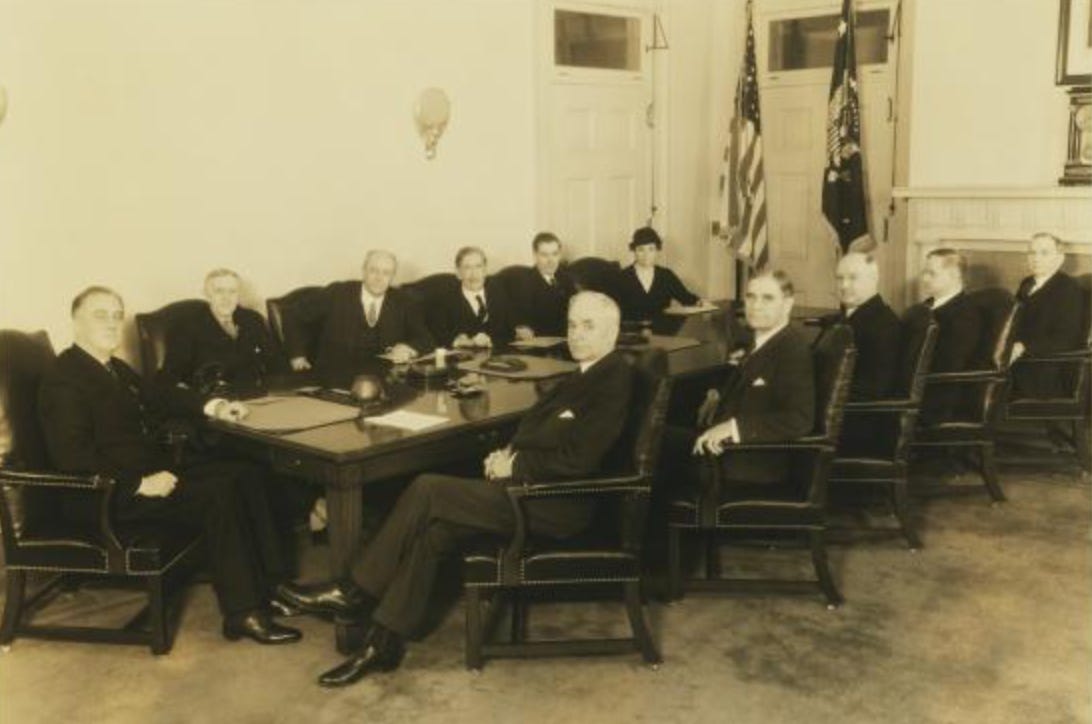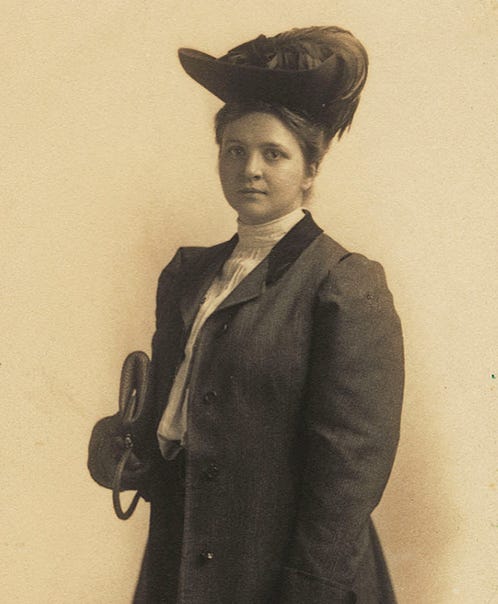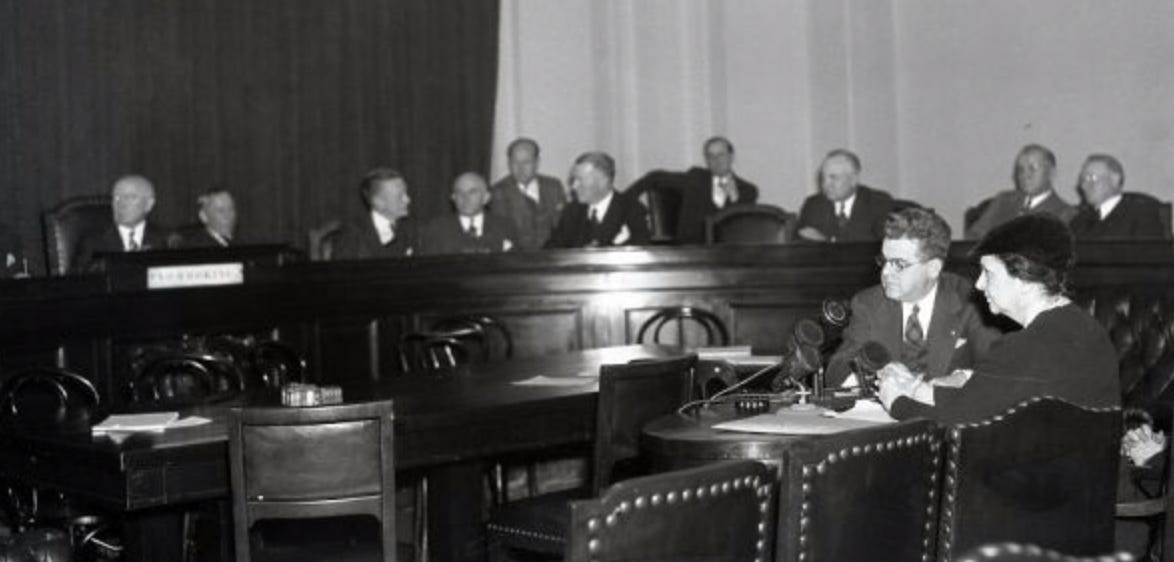President Franklin D. Roosevelt and Vice President John Nance Garner were sworn in by Chief Justice Charles Evans Hughes on the East Portico of the Capitol on Saturday, March 4, 1933. That inauguration was the last time the ceremony would be held in March. Two months earlier the country had ratified the Twentieth Amendment, changing the dates set by the Constitution to January 20 for the president and vice president and January 3 for House and Senate members. Given advances in transportation and the disadvantages of a lengthy lame-duck season, especially in times of crisis, the change had broad support.
That afternoon, the Senate completed confirming FDR’s Cabinet. That evening, the entire Cabinet was sworn in at the White House, by Supreme Court Justice Benjamin Cardozo. In the upstairs study, in order of precedence, each secretary took the oath of office and shook the President’s hand. FDR’s Cabinet included three Republicans, two Senators, nine men and one woman, Frances Perkins, as Secretary of Labor. Described as “a little family party,” supper for sixty was served before the presidential party departed for the inaugural ball.
August 14, 1933
The next day the President called a special session of Congress to declare a four-day bank holiday and pass the Emergency Banking Act, which he signed on March 9, launching the first Hundred Days of the New Deal. The Cabinet convened on March 7. Aware of being the “first and only,” Perkins adopted the same demeanor she had used throughout her career. As the Vice President reported to his wife, “She didn’t interrupt. She didn’t butt in. She didn’t ask any questions. She kept still until the president asked her what she had to say. Then she said it. She said it loud enough so I could hear. She said it plain and distinct.” Perkins had been the singular woman in smoke-filled rooms for more than twenty years.
FDR’s first Cabinet meeting, March 7, 1933
Born in Boston in 1880 to parents originally from Maine, she graduated from Mount Holyoke College in 1902 with a degree in chemistry and physics. Perkins moved first to Chicago, to volunteer at Hull House and teach, and then to New York City, to work at the Consumers League and pursue a degree in economics and sociology at Columbia University.
By horrible happenstance, she was nearby when the Triangle Shirtwaist Factory caught fire on March 25, 1911. It killed 146 workers, many the daughters of Jewish immigrants who jumped to their deaths. The owners responsible for its unsafe conditions were acquitted of manslaughter and fined twenty dollars for locking the fire escape doors. Perkins recalled the tragedy as “the day the New Deal was born.”
She became a fierce advocate of industrial safety, investigating factory accidents and allying with Democrats to propose a bill limiting working hours to fifty-four a week. When she lobbied state legislator Franklin Roosevelt, she was not impressed. Working in Albany prompted Perkins to don her disguise of dowdiness, with shapeless clothes and her trademark tricorn hat. She believed men would respond more favorably to a woman who looked like their mothers and “didn’t buzz-buzz all the time.” She would not always conceal her opinions.
Her work prompted Governor Al Smith to appoint her to the New York Industrial Commission, a post she held for his four terms. Elected governor in 1928, FDR named her Chief Commissioner, making her the highest-ranking state labor official in the country. There were no questions about her qualifications to be Secretary of Labor, but Perkins hesitated to accept the president-elect’s offer until he agreed to her conditions.
They included: support for “a forty-hour work week, a minimum wage, worker’s compensation, unemployment compensation, a federal law banning child labor, direct federal aid for unemployment relief, social security, a revitalized public employment service and health insurance.” Roosevelt agreed and she proceeded to secure far-reaching social welfare legislation.
One of Herbert Hoover’s efforts to reverse the Depression was the Economy Act of 1932. Section 213 required the government to fire one member of any married pair of federal workers. It did not forbid federal jobs to fathers and sons. To avoid fraud, it required women to use their married names. The bill was repealed in 1937 but attitudes did not change. Bans on married women teachers were common.
After marrying Paul Wilson in 1913, Perkins kept her name professionally. Their love match was shaken by his extramarital affair and depression and her attempts to balance work and homemaking. She had suggested a separation in 1915 when she became pregnant. Three pregnancies resulted in a miscarriage, a stillborn son, and the birth a daughter. Frances hoped to be a full-time mother, but circumstances demanded she become the family breadwinner.
Few people knew Secretary Perkins was married, supporting a mentally-ill husband and their daughter in New York.
As Secretary of Labor, Perkins accomplished all her goals except universal health insurance. Her first proposal created the Civilian Conservation Corps, which employed unmarried men, ages eighteen to twenty-five, to build trails and shelters and plant 3.5 billion trees in 800 state and national parks, in racially segregated units. The CCC coordinated with the Emergency Educational Program to teach basic literacy.
Male administrators objected to women working outdoors so Perkins, supported by the First Lady, established integrated camps for single women “without resources,” ages eighteen to forty-five. CCC men earned a dollar a day; the women got an allowance of fifty cents a week.
Perkins’ signature achievement was the Social Security Act of 1935. During the Depression, state pension plans served only 3% of the target population. Poverty rates among the old and unemployed soared. Caught between Congressional conservatives and populist ideologues, Perkins’ team proposed employee payroll contributions to fund payouts based on prior earnings. Because no one would have contributed yet, to fund the initiative, the Treasury Secretary suggested eliminating coverage for farm workers, domestic servants and employees of businesses with fewer than ten people, leaving 9.4 million workers, disproportionally Black and female, at risk.
FDR signing the Social Security Act, August 14, 1935
The final bill provided unemployment insurance, old age pensions, immediate grants to states for relief of the indigent elderly, Aid to Dependent Children (ADC) and minimal funding for public health. The ADC was imperative, Perkins aserted, for “rearing fatherless families” when so many men had left home to find work. The Supreme Court threatened to declare both Social Security and the National Labor Relations Act unconstitutional.
FDR’s court-packing plan made passage of the Fair Labor Standards Act of 1938 (FLSA) difficult. For industries engaged in interstate commerce with annual earnings of $500,000, FLSA mandated an eight-hour day, a forty-hour week, a minimum wage keyed to inflation, overtime pay and an end to child labor for those under sixteen. FLSA applied to only 20% of the workforce and 14% of jobs held by women, including those in the garment industry. To secure Southern votes, it excluded most of the jobs held by Black workers, which would have a negative financial impact on generations of people.
FLSA would not have passed without Perkins; Molly Dewson, head of the DNC Women’s Division; Grace Abbott, former head of the Children’s Bureau; and Congresswoman Mary Norton (D-NJ), who had been elected in 1924 and risen to chair of the House Labor Committee. Norton reported the bill out of committee, pried it loose from the Rules Committee with a rarely used discharge petition and secured its passage without amendments. For progressives, FLSA was the culmination of a forty-year campaign. It was the only New Deal initiative to pass after 1936.
Perkins was less sympathetic to Black Americans than to European Jews seeking asylum from Nazi Germany. Her creative attempts to work around the restrictive quotas imposed by the 1924 Immigration Act and overcome what Eleanor Roosevelt called the “striped pants bigotry” of the State Department, failed. A new book, Dear Miss Perkins, describes her efforts.
PINK author Griffith & PERKINS author Rebecca Brenner Graham
Despite, or because of the success of what Forbes called the “Perkins’ New Deal,” she lost favor with Congress and Roosevelt. She was impeached by the House in 1939, only the second cabinet member to be charged. (The first was Secretary of War William Belknap in 1876.) The cause was her refusal to be stampeded into deporting Harry Bridges, an Australian longshoreman and labor organizer suspected of being a Communist. Conducting her own investigation, she found him “detestable” but not dangerous.
Her delay, supported by FDR, prompted the House to create a Special Committee to Investigate Un-American Activities in 1938. Believing that Communism was a greater threat than fascism, it attacked Perkins over Bridges. Then it investigated Frances. She was accused of falsifying records (which she had by altering her age by two years), having an affair with Bridges and being illegitimately married, Jewish and therefore a Communist. She finally responded with details and documents, stating, “The utter un-Americanism of such a whispering campaign, the appeal to racial prejudice and the attempt at political propaganda by unworthy innuendo must be repugnant to all honorable men and women.”
Impeachment was introduced in a Democratic Congress. Almost no one defended her. Many considered the committee and the charges a “laughing matter” but few spoke up. Roosevelt did not support her publicly or privately, made light of the matter in press conferences and stopped mentioning her name. Perkins hid her rage, took the high ground and retreated to a cloistered Catholic convent whenever she could.
The House Judiciary Committee, chaired by a Southern Democrat, delayed hearings and then refused her request to open them to the public. She began her testimony by thanking the members for “their enormous sense of justice [and] their great courtesy,” before laying out the facts. On March 24, 1939, the Judiciary Committee unanimously ruled that there were insufficient facts to proceed.
Secretary Perkins testifying before the House Judiciary Committee, 1939
Perkins’ reputation was shredded. Never a DC insider nor an Eleanor intimate, she was now politically isolated. Immigration oversight was moved from the Labor Department to Justice.
After Pearl Harbor, FDR stripped other offices from her and excluded her from wartime agencies dealing with workers. Perkins’ department shrank in size along with her influence.
Although she testified against passage of the Equal Rights Amendment in 1943, she pressed for recruiting women for wartime production but against their conscription. She wanted to pursue national health insurance, but FDR focused on international concerns. She did persuade him to support a postwar International Labor Organization.
Frances Perkins and Harold Ickes, the liberal Republican Secretary of Interior, were the only original Cabinet members to serve Roosevelt until he died in April 1945. Truman replaced her but appointed her to the Civil Service Commission. She remained until 1952, when Truman retired and her husband died. She wrote an unrevealing memoir, The Roosevelt I Knew (1947), and taught at Cornell until she died in 1965, age 85. She had always worked.
In 2024, President Biden stood in front of the Department of Labor’s Frances Perkins Building, named by President Carter in 1980, to designate the Perkins Homestead in Maine a National Monument. The woman who was the leading architect of the New Deal is now an answer on Jeopardy. Only champion contenders would recall the scene from Dirty Dancing, in which Patrick Swayze’s character asks, “What’s your real name, Baby?” “Frances, after the first woman in the Cabinet.” “That’s a real grownup name.”
Despite being handicapped by sexism and family dysfunction, by reforming American labor practices, Frances Perkins improved the lives of every American. She was a definitely a grownup.
Perkins & Eleanor Roosevelt, at the 50th anniversary of the Triangle Fire, March 1961
SOURCES:
Photo credits: public domain; Mount Holyoke Archives; Brandon Graham.
Kirsten Downey, The Woman Behind the New Deal: The Life of Frances Perkins, FDR’s Secretary of Labor and His Moral Conscience (Doubleday, 2009).
“On This Day: March 4: Cabinet Sworn in at White House” New York Times Archives, https://archive.nytimes.com/www.nytimes.com/learning/general/onthisday/990304onthisday_big.html
Elisabeth Griffith, FORMIDABLE: American Women and the Fight for Equality, 1920-2020 (Pegasus, 2022).
Rebecca Brenner Graham, Dear Miss Perkins: A Story of Frances Perkins’s Efforts to Aid Refugees from Nazi Germany (Citadel, 2025).













I just finished the historical novel based on her life: Becoming Madam Secretary by Stephanie Dray. Excellent read
I so admire Frances Perkins, so thank-you for this vignette. But I had little idea of her losing her huge influence on FDR and the country as the years wore on. Yet she hung in there until the end of the administration - and seems to have made up with Eleanor by the time of JFK.